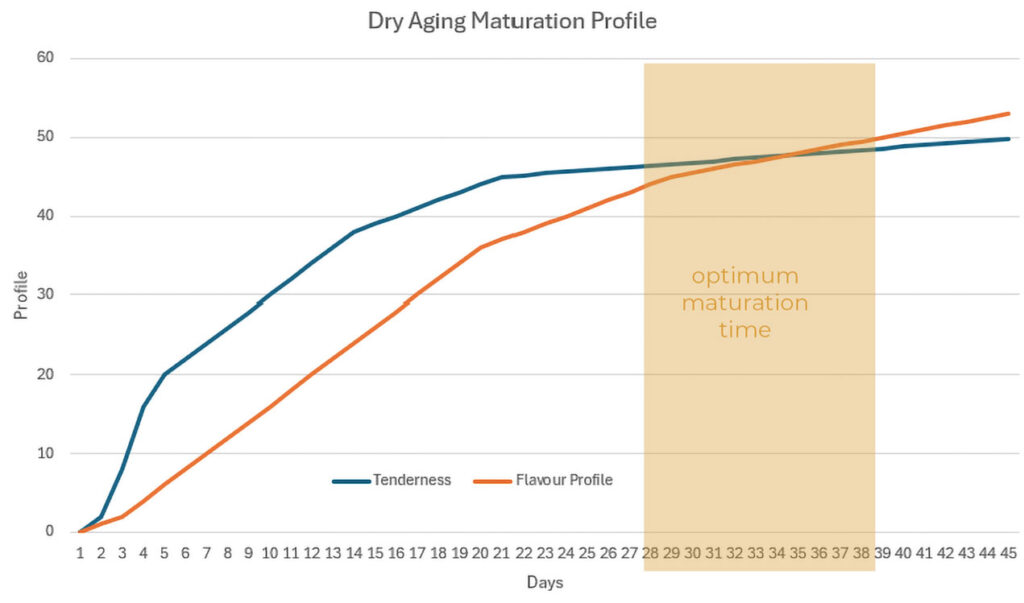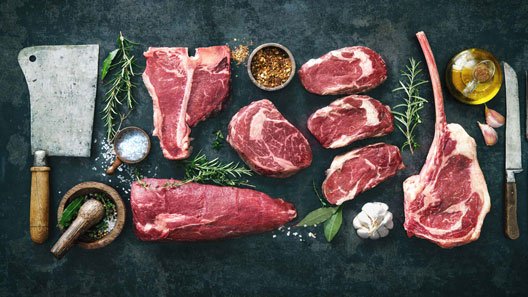No products in the cart.
Dry aging beef, a technique revered by butchers, chefs and connoisseurs alike, is an intricate process that enhances the flavor and tenderness of beef. This culinary practice, which involves aging meat without packaging in a controlled environment, combines scientific principles with the artistry of the artisan butcher. This article delves into the scientific rationale behind dry aging and explores the artistic nuances that make it a celebrated technique in the culinary world.
At the heart of dry aging is a series of biochemical processes that transform the texture and taste of beef. The key factors in these processes include moisture evaporation, enzyme activity, and microbial action.
The initial phase of dry aging involves moisture evaporation from the muscle tissue. As the beef ages, water slowly evaporates from the surface, concentrating the meat’s flavor. This process of dehydration creates a greater depth of flavor, often described as richer and beefier compared to fresh, non-aged meat.
The most critical component of dry aging is the breakdown of muscle proteins and connective tissues by natural enzymes found in the meat. These enzymes, including cathepsins and calpains, gradually tenderize the meat by breaking down complex proteins into simpler amino acids, enhancing the meat’s flavor profile. This enzymatic breakdown not only tenderizes the meat but also contributes to the development of nutty, buttery, and complex flavor notes unique to dry-aged beef.

The majority of the main processes of moisture evaporation (flavour enhancement) and enzyme activity (tenderness improvement) take place during the first 21 days after which any further time is more of an artistic choice based on experience and also the particular cut being matured.
Our target is to achieve maximum beefy flavours, with a slight earthy nuttiness which enhances the sweetness that comes from the grass fed beef. We are not after the flavour profile associated with game meat. This is why we aim for between 28 days and 38 days maturation on all our Black Label Brand steak meats.
While the idea of microbial growth on food often raises concerns, in the controlled environment of dry aging, certain beneficial microbes play a significant role. These microbes, primarily molds and bacteria that are naturally present in the air, form a protective crust on the exterior of the meat. This crust acts as a barrier, preventing spoilage and contributing to the flavor development of the beef. The molds and bacteria break down fats and proteins on the surface, adding to the complexity of flavors in the aged beef.
Beyond the scientific processes, dry aging is also an art that requires skill, patience, and attention to detail. The artistry involves selecting the right cuts, controlling the aging environment meticulously, and knowing when the meat has reached its peak flavor and texture.
Not all cuts of beef are suitable for dry aging. The process is best suited to larger, bone-in cuts with a good amount of marbling (fat within the muscle). The fat not only contributes to flavor but also helps protect the meat during the aging process. Prime cuts for dry aging include rib, sirloin, rump and fillet, in other words the steak cuts. Other cuts do not really benefit from this process to the same extent.
The environment in which beef is dry aged is crucial to the process. The temperature, humidity, air quality and airflow must be carefully controlled to prevent spoilage while allowing the meat to age properly. Typically, the temperature is kept just above freezing, with humidity levels around 80-85%, and sufficient airflow to ensure even drying. In our case we even purify the air to inhibit excessive bacterial growthMastery over these environmental factors is essential for producing high-quality dry-aged beef.
Determining the optimal aging period is where the artistry of dry aging truly comes into play. While the general range for dry aging is between 21 and 45 days, the exact duration depends on the cut of meat and the desired flavor profile. This decision requires intuition and experience, as the meat’s character changes over time. Some chefs and butchers push the boundaries, aging beef for several months to achieve a more concentrated flavor and unique texture.
The science and art of dry aging beef merge to create a product that is vastly superior in flavor and tenderness to its non-aged counterparts. Through the meticulous control of environmental factors and a deep understanding of the biochemical processes at work, chefs and butchers transform ordinary cuts of beef into exquisite culinary delights. Dry-aged beef, with its complex flavors and tender texture, stands as a testament to the synergy between science and artistry in the culinary world.
Depending on the type of steak these are the sizes we recommend based on appetite. Standard would be a typical restaurant size and red would be our choice.

4oz small
6oz standard
7oz medium
8oz large
10oz extra large
6oz sandwich
7oz medium
8oz standard
10oz large
12oz extra large
6oz small
7oz medium
8oz standard
10oz large
12oz extra large
16oz huge